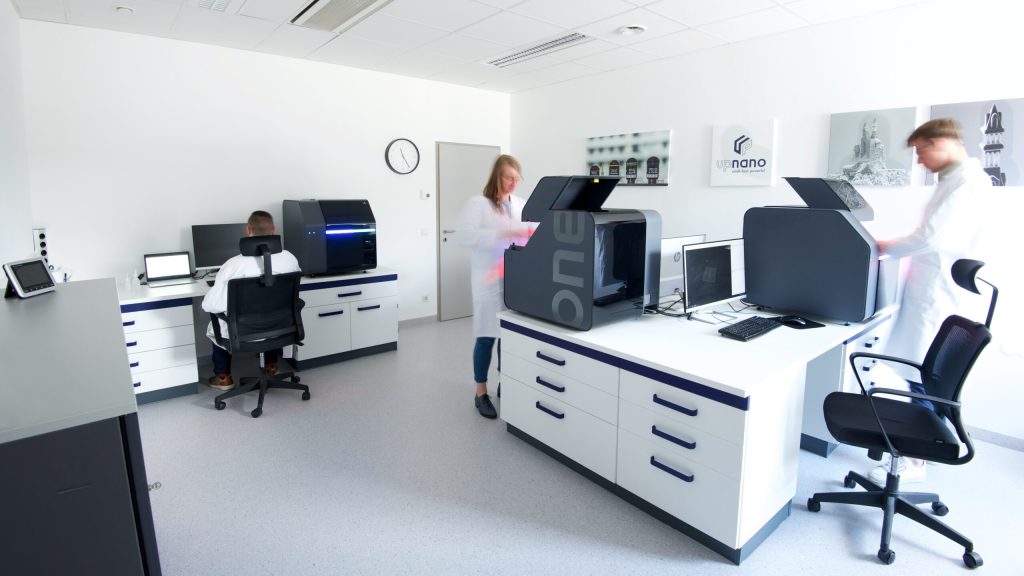The 2021 3D Printing Industry Awards shortlists are now open for voting until the 20th of October. Cast your votes here.
UpNano, a Vienna-based manufacturer of high-precision 3D printers, has developed two new resins for use with its 2-photon polymerization (2PP) 3D printing technology.
Named UpBlack and UpOpto, the photopolymer materials enable the printing of non-transmitting black and translucent parts, respectively. The company states that its latest offerings can be combined to 3D print entire optical systems, including components such as casings and lenses, using the firm’s proprietary NanoOne 3D printer.
“We have a complementary optical transparent material in our commercially available materials range,” said Bernhard Küenburg, CEO of UpNano. “Called UpOpto, this material benefits from exhibiting very low fluorescence, which often interferes with many optical, biological, and medical applications.”
According to UpNano, several of the company’s customers have already leveraged the new material combination in their day-to-day operations, including a large tech conglomerate based in Asia.

Clearing the black barrier with NanoOne
The NanoOne 3D printer is based on 2PP technology, a precise form of resin-based 3D printing capable of producing parts with nano- and micrometer resolutions across 12 orders of magnitude. UpNano has also equipped its flagship system with an optimized optical pathway, patented adaptive resolution technology, and smart algorithms for laser scanning.
Due to the absorptive nature of black, 3D printing with black resins has always had issues when it came to the polymerization efficiency of the printing process. UpNano claims to have solved this problem using brute force, attributing the performance capabilities of UpBlack to the exceptionally high laser power of its NanoOne 3D printer.
The 2PP system benefits from a 1W laser, which the company began offering as standard back in late 2020. Despite the relatively high light absorption of UpBlack resin, the 1W laser reportedly still delivers enough energy for full-scale polymerization to take place, resulting in robust black parts from the mesoscale down to the micron scale.

UpBlack and UpOpto for optical systems
Optical assemblies often require both absorptive and translucent/transparent components, with the former being used for structural applications and the latter being used for parts such as lenses. UpBlack and UpOpto were specifically designed to address these needs, with UpOpto even benefitting from biocompatibility and non-cytotoxicity certified in accordance with EN ISO 10993-5:2009. This makes the resin a great tool for users working with medical devices and microfluidics systems.
Just recently, UpNano also received certifications for the ISO 9001 and ISO 14001 standards, proving it has an effective quality management system and an environmental management system in place. The achievements come as UpNano launched its NanoOne Bio 3D bioprinting system, doubled its employee count, and vastly increased the floor space of its Vienna headquarters over the past year.
Küenburg adds, “During the last two years, our sales of 3D printers and materials grew strongly. At the same time, we heavily invested in the company’s expansion. This growth of UpNano has to be accompanied by a strong focus on quality management, and the ISO 9001 certification testifies that we were able to achieve that.”

The resin 3D printing space has been home to several materials advancements in recent months. In September, 3D printer manufacturer B9Creations launched a new line of resins that it says can be used to create injection molding-quality plastic molds. Included in the ‘Robust’ range is an ABS and polycarbonate (PC) material that features a high heat deflection temperature (HDT), along with an engineering-grade ABS for strong and stiff parts.
Elsewhere, Tethon 3D, a specialist in ceramic 3D printing, recently partnered with additive manufacturing materials company Mechnano to develop a novel high-temperature, ESD-safe resin for use with SLA-based 3D printers. Named C-lite, the photoresin can withstand temperatures of up to 225°C and integrates Mechnano’s proprietary carbon nanotube (CNT) technology.
Subscribe to the 3D Printing Industry newsletter for the latest news in additive manufacturing. You can also stay connected by following us on Twitter, liking us on Facebook, and tuning into the 3D Printing Industry YouTube Channel.
Looking for a career in additive manufacturing? Visit 3D Printing Jobs for a selection of roles in the industry.
Featured image shows microlenses 3D printed using UpBlack and UpOpto. Photo via UpNano.


